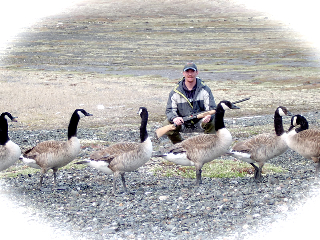Enterprising People of a Feather
"It will be a big deal. We've already had a fair influx of people selling us [eider duck] down."
"That's a big deal [the opening of 15 jobs in full-time employment] in a town of 850 people."
"I wasn't going to do this unless I knew, long term, it was going to be feasible."
Daryl Dibblee, administrator, Sanikiluaq, Nunavut
 |
| With no caribou on their islands, Inuit on the Belcher Islands have relied on eider ducks for food and clothing for generations. Here, an Inuit woman wearing a traditional eider skin parka collects duck eggs in a still photo from the film People of a Feather. (Joel Heath/Handout photo/Canadian Press) |
"How do they use their skills to come up with jobs that are meaningful to them? The eiderdown factory is a great example of that."
"Having long-term jobs for Inuit, working together to try and understand what's happening in Hudson Bay ... the idea is, in the long term (southerners) don't need to be there."
"The communities have enough knowledge to run the programs themselves."
Joel Heath, Canadian scientist

A documentary titled People of a Feather was produced by Dr. Heath, demonstrating the reliance and relationship that the town has with the ducks in their provision of food and clothing. Perhaps the larger purpose of the film was to track changes gradually occurring to the environment. Immense hydro reservoirs in Quebec store freshwater that once teemed into Hudson Bay during the spring. Kept in reservoirs now, the water is released in the winter for the generation of power for cities in the south.
According to Dr. Heath, a 24 metre-deep layer of freshwater exists along all of Hudson Bay's eastern coast, as a result of this manipulation of nature. Ice is known to form earlier in the fall since freshwater freezes more quickly than sea water. The result is large flocks of ducks trapped on shrinking pools of open water. It occurred to Dr. Heath that since the Inuit communities are right there on site, observing the changes to their environment, who better to monitor the changes?
 |
| Inuit man wearing traditional eiderdown parka |
With the use of Google Maps technology, Dr. Heath has taught the locals how to gather and share real-time information along the coast. That information is timely and useful for dissemination, to alert hunters. Above all, it is increasingly critical to disseminate the information gleaned about weather and environment conditions to alert people planning to travel on the sea ice. Knowing the condition of the sea ice can avert tragedies.
While the indigenous residents are making use of that information they are also now reinvigorating an earlier eiderdown industry. In the town of Sanikiluaq an existing eider factory has begun buying up eiderdown that has been collected by Inuit families from the proliferation of nests nearby the town, built by the birds. The two are interrelated, since the birds are affected by ice conditions, and in turn the Inuit are affected by any deleterious effects on the birds which they rely upon.
The large seabirds nest in immense numbers in the Belcher Islands. The female duck plucks down from her breast to line her nest which will contain the eggs she lays. Down collectors pluck down from the nests before the eggs have hatched, taking care to take only a portion of the fluff. The down that is collected makes its way to the factory, is cleaned, sterilized and sewn into parkas and duvets. One nest is capable of producing 70 grams of eiderdown.
 |
| Photo from Sanikiluaq Hamlet website |
And eiderdown just happens to represent the warmest, most durable insulation produced by nature. Iceland produces most of the world's eiderdown production, estimated at four tonnes. Its relative rarity accounts for its sky-high price. Uncleaned down brings in $330 a kilogram with finished duvets priced at up to $10,000. The hamlet located on Flaherty Island, the southeast corner of Hudson Bay, plans to sell cleaned down to manufacturers in Europe, along with parkas and duvets sewn traditionally by local women.
Belcher Islands Designs operates the eiderdown factory. The plant is forecasted to break even by its second year of operation and is expected to produce a $200,000 profit by its third operating year. To run the operation, fifteen full-time jobs will be created. People skilled traditionally are the fulcrum of the enterprise. The down sterilizers and the eight industrial sewing machines were imported into the community.
Labels: Aboriginal Populations, Arctic, Canada, Industry, Nature

0 Comments:
Post a Comment
<< Home